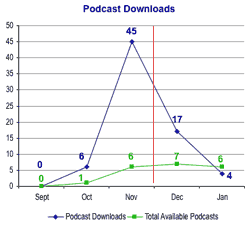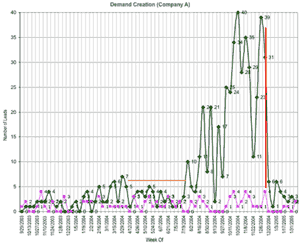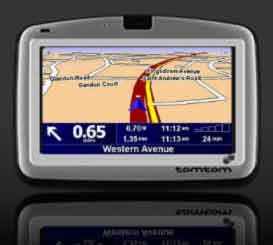Friday, May 26, 2006
Show Me The (Podcasting) Money
While some marketers are finding ways to gain podcasting revenue through advertising (Brandweek & eMarketer/New York claim ad revenue for podcasting will reach $80 million in 2006), in the B2B services sector I believe that the most valuable revenue will not come from selling (or buying) podcast ad space but will come instead through developing a podcasting strategy that cultivates a thought-leadership position for the company among its customers and influencers. With the proper messaging and tone, podcasting in this way adds another dimension to the marketing and brand channel mix that will ultimately lead to a tangible, financial return on investment.
I discovered this first hand while helping launch a new business unit for a client. As one component of a multi-channel demand creation strategy, we used podcasts of the company leaders speaking about industry dynamics and some of the pain points experienced by customers to subtly let them know we understood their world — and without a single salesy message in the podcast itself. A consistent release schedule of at least one podcast episode per week not only rapidly boosted downloads of the podcasts, but over two and a half months played a role in growing the sales opportunity pipeline from $US 23 million to $US 112 million. Worth noting, is the fact that when management halted support of the overall demand creation strategy (including podcasting) at the end of November, the podcast download traffic showed an immediate and extreme sensitivity to the lack of new content, dropping by more than 62% in less than 1 month. That downward trend continued even though the same number of audio files continued to be available on the web site — there was just nothing new to listen to.
I believe this means that for most B2B companies (especially those in industries with tech-savvy customers and where there is a complicated sell), there is tremendous long-term value potential in integrating a podcasting strategy into the marketing mix — as long as the content is positioned properly to address customer pain points. It should not become an exercise in chest beating to broadcast how great the company is at providing this and that and it needs to be given long-term commitment by senior management to reach that potential.
Sources:
Anderson, Diane. “Podcasting Ads Reel in $80M” Brandweek. March 6, 2006. pg 16
eMarketer – Market Research on E-Business and Online Marketing
Chart: client data
Thursday, May 18, 2006
The Rise and Fall of a Demand Creation Strategy: A Case Study
Marketers know a successful demand creation strategy requires a commitment not only financially but of support from senior management. Unfortunately, while the benefits of an integrated, multi-channel demand creation strategy for a business are enormous, building an opportunity pipeline typically takes more time than many companies have the stamina for. I’ve enjoyed seeing challenging lead generation work pay off and I’ve also been on the receiving end when a short-sighted management team pulled the plug. Many times I wished I had some data on hand as ammunition for discussions with the CEO when the future of the plan (and business!) was on the line. The following case study tracks the lead growth of Company A, a healthcare sales & marketing services company, over the course of two years with business-to-business prospects. It demonstrates how continuous support and funding of a demand-creation strategy builds momentum over time while a cut-off of support quickly and dramatically erodes growth gains.
In the Beginning
The chart shows that it takes some time to sort out the right marketing channel mix and build momentum. During this phase many resources were put into building awareness along with targeted initiatives to seed a long-term pipeline. Over the course of 1 year, a multi-channel integrated demand creation strategy increased lead volume from an average of 3 to 20 leads per week. At the same time, unqualified leads (magenta trend line) were reduced and qualified leads (green trend line) rose from 57.5% to 89.8% of all leads.
Still, particularly in the early stages, momentum is fragile. The yellow bar shows the effect on lead generation of halting journal advertising and reducing multi-channel initiatives for 4 months due to sudden budget cutbacks. When all available demand creation channels in the integrated plan were restored, lead generation rebounded and grew exponentially.
The Great Crash
Unfortunately, despite the high volume of qualified leads turned over to business development, an opportunity pipeline of over $US 60 million for the year and a visibility of 2-3 years on future prospects for lead nurturing, senior management ended support and funding of resources for the integrated plan in mid-December (red line). The dropoff was more catastrophic than I could ever have predicted. With a decimated lead pipeline and stock price that ultimately lost more than 55% of its value, two years later the company still struggles to recapture what was lost. It is a cautionary tale worth sharing with management: cut marketing at your own peril.
Note: This post is a portion of an expanded article I’m preparing on marketing momentum. If you’d like to be notified when it is available for download contact me.
Source: Internal Study Sept 2003 – Feb 2005
Sunday, May 07, 2006
Dunkin Donuts is Watching You
Recently Brandweek reported a February 2006 licensing agreement between Dunkin Donuts and in-car GPS manufacturer TomTom allowing customers to download Dunkin Donuts and Baskin Robbins logos onto their in-car GPS systems so the chains show up on the driving map when a store is in the vicinity. 1 This is a convenience for the driver to be sure, but an even greater boon for Dunkin Donuts’ marketing execs: the act of downloading leaves an electronic trail of breadcrumbs (or is it donut bits?) to observe how many people on the system have accessed the brand signposts. I wouldn’t be surprised if there wasn’t some sort of agreement that lets advertisers like Dunkin Donuts access GPS data to see whether someone actually drove to one of the sponsored stores, maybe even how long they were at that location. And its probably worth some expense for marketers to use this channel to gain further insight into the lucrative demographic that typically buys the $US 699.00 systems: 45% earned $75,000+ yearly and 34% earned between $100,000 and $150,000 each year.2 The smart advertisers would then use behavioral triggers to send additional targeted offers to these subscribers.
TomTom would like to ink similar licensing agreements with other brands and I’ll bet other GPS manufacturers have started looking at supplementary revenue streams in this area as well. And so it seems we’re yet another step closer to the kind of intrusive advertising I posted about over a year ago and seen to the extreme in the 2002 movie Minority Report.
On the other hand, such advertising may not be so “intrusive” if it targets my needs with relevant offers at the right time. The challenge is that most advertisers aren’t so adept at delivering on that promise yet. And with all the beeping and flashing logos soon to populate these GPS devices it won’t be long before municipalities start legislating when and how you can use your distracting GPS device in a car, much like the situation in many U.S. states where hand held mobile phone use while driving is banned.
Oh yeah…TomTom also provides GPS solutions for PDAs and mobile phones, so I gather marketers will soon be able to target customers as they’re walking around town. So your PDA/phone suddenly chimes to life with a new message: ‘Why not stroll into the corner Starbucks for a cup before your 11 am meeting, Mr. Anderton?’
Sources:
1 Hein, Kenneth. “Marketers Map Out Their GPS Ad Plans.” Brandweek. April 24, 2006. pg 4.
2 NPD 3-month Survey
Joseph Mann “Behavioral Targeting, Morphing Taxis and the World of Minority Report.” Marketing & Graphic Design ROI Blog. March 20, 2005.


